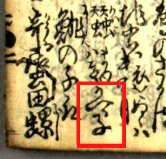Tadpoles and snails (I hear and obey)
Joel talks snails and tadpoles before invoking the me-signal. It's on!
One reason that it's hard to find haiku about otamajakushi (tadpoles) is because otamajakushi is a relatively new word -- like Joel says, it was originally used to refer to a ladle with a big round scoop (hence tama, "ball"). A regular shakushi has a shallower scoop, almost like a spatula, but that word isn't used much any more: like many kitchen-related items, it went through the nyobokotoba ("women's language") machine and came out shamoji ("Sha-word").
And in fact, the o- at the start of otamajakushi reveals that it, too, was forged in the fires of medieval Japanese women's language. What's more, it has been shortened in the centuries since to otama, and otamajakushi pretty much always means "tadpole". But there was a long period in between, I imagine, where there was some severe overlap, and calling tadpoles otamajakushi struck folks as far too cutesy for use in serious poetry.
So what were they called before the invention of the ladle? Kaeru no ko or kaerugo (frog children), or the Chinese word for tadpole kato (蝌蚪). This site has more information, and even a modern haiku that does use the word otamajakushi, by MASAOKA Shiki (natch):
裏溝やお玉杓子の水ぬるむ
"The ditch out back: tadpole water warming up." (Mizu nurumu is a standard haiku "season phrase" for spring.)

(かへる子 listed as a "second month"
seasonal word for haikai in Kefukigusa.
Kawazu is given as a mid-Spring word
for linked verse.
As for katatsumuri and dendenmushi for "snail", YANAGITA Kunio (柳田國男) ground the subject to a fine paste in Kagyū kō (蝸牛考, "On snails") and I recommend it to anyone interested in Japanese regional variation in non-aquatic mollusc-related terminology. (Yes, both of you.)
I understand that Yanagita himself had grave doubts about the broader ideas he expressed in the book -- the "center versus periphery" part about culture radiating outwards in concentric circles from Kyoto to the edges of the Japanese archipelago, I guess? -- but the hundreds of different words for "snail" he collected are still impressive. To summarize his interpretation:
- Katatsumuri probably does mean "hard head" or "hard round-thing", and is the oldest word specifically meaning "snail" that is still in the mainstream;
- Maimai (mushi) is slightly newer. The maimai probably refers to the spiral shell. The word is mostly extinct in central Japan but still going quite strong around Tokyo.
- Dendenmushi is the newest of all and probably originated in or around Kyoto thanks to a song in which the snail is ordered to "come out, come out" (dero, dero).
Three other great words for "snail" to close: hebitama (snake-ball), iekatsugi (house-shoulderer), and gamahime (toad/pot princess? some variant of maimai?).
![[No-sword]](http://no-sword.jp/images/site/no-sword_banner.jpg)



Joel:
Merci beaucoup!